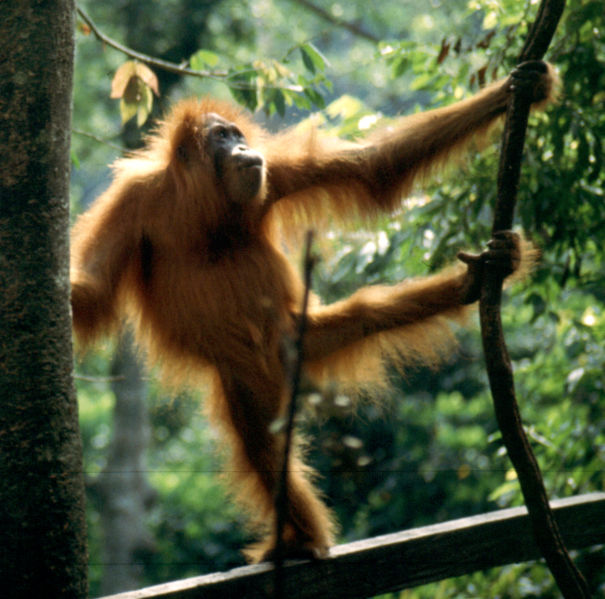- Sumatran Orangutan
Taxobox
name = Sumatran OrangutanMSW3 Groves|id=12100804]
status = CR
status_ref = IUCN2007 | assessors = Singleton, I., Wich, S.A. & Griffiths, M. | year = 2007 | id = 39780 | title = Pongo abelii | downloaded =2007-09-13 Database entry includes justification for why this species is critically endangered]
trend = unknown
status_system = iucn3.1

image_width = 220px
regnum =Animal ia
phylum =Chordata
classis =Mammal ia
ordo =Primates
familia =Hominidae
subfamilia =Ponginae
genus = "Pongo"
species = "P. abelii"
binomial = "Pongo abelii"
binomial_authority = Lesson, 1827The Sumatran Orangutan ("Pongo abelii") is the rarer of the two species oforangutan s. Living and endemic toSumatra island ofIndonesia , they are smaller than theBornean Orangutan . The Sumatran Orangutan grows to about 4.6 feet tall and 200 pounds in males. Females are smaller, averaging 3 feet and 100 pounds.Compared to the Bornean Orangutan, the Sumatran Orangutans possess a lighter and longer
pelage , a longer face, a smaller stature, and flanges that are covered in small white hairs.Fact|date=October 2007Ecology
Compared to the Bornean Orangutan, the Sumatran Orangutan tends to be more
frugivorous and especiallyinsectivorous . Preferred fruits includefig s andjackfruit s. It also will eat bird eggs and small vertebrates. [ [http://www.bbc.co.uk/nature/wildfacts/factfiles/360.shtml BBC - Science & Nature - Wildfacts - Sumatran orangutan] ] The Sumatran Orangutans spend far less time feeding on the inner bark of trees.Wild Sumatran Orangutans in the Suaq Balimbing swamp have been observed using tools. [Zimmer, Carl "Tooling through the trees - tool use by wild orangutans" Discover Magazine, November 1995] An orangutan will break off a tree branch that's about a foot long, snap off the twigs and fray one end. It then will use the stick to dig in tree holes for termites. They'll also use the stick to poke a bees nest wall, move it around and catch the honey. In addition, orangutans use tools to eat fruit. When the fruit of the
Neesia tree ripens, its hard, ridged husk softens until it falls open. Inside are seeds that the orangutans love, but they are surrounded by fiberglass-like hairs that are painful if eaten. A Neesia-eating orangutan will select a five-inch stick, strip off its bark, and then carefully collect the hairs with it. Once the fruit is safe, the ape will eat the seeds using the stick or its fingers. Although similar swamps can be found in Borneo, wild Bornean Orangutans have not been seen using these types of tools.NHNZ filmed the Sumatran Orangutan for its show "Wild Asia: In the Realm of the Red Ape"; it showed one of them using a simple tool, a twig, to pry food from difficult places. There is also a sequence of an animal using a large leaf as an umbrella in a tropical rainstorm.The Sumatran Orangutan is also more arboreal than its Bornean cousin; this could be because of the presence of large predators like the
Sumatran Tiger . It moves through the trees bybrachiation .Life cycle
The Sumatran Orangutan is more social than its Bornean counterpart. Groups of these orangutans gather to feed on the mass amount of fruiting on the fig trees. However adult males generally avoid contact with other adult males. Rape is common among orangutans. Sub-adult males will try to mate with any female, though they probably mostly fail to impregnate them since mature females are easily capable of fending them off. Mature females prefer to mate with mature males.
Interval birth rates for Sumatran Orangutan were longer than the Bornean ones and are the longest reported interval birth rates among the
great ape s. Sumatran orangutans give birth when they are about 15 years old. Infant orangutans will stay close to their mother for up to three years. Even after that, the young will still associate with their mother.Both orangutan species are likely to live several decades; the longevity estimate can span for more than 50 years, with the oldest captive orangutan,
Ah Meng , being born in 1960. [cite news| title = Singapore’s most famous ape celebrates 46th birthday | url = http://www.khaleejtimes.com/DisplayArticleNew.asp?xfile=data/theworld/2006/June/theworld_June523.xml§ion=theworld | publisher = Khaleej Times|date=18 June 2006]Nonja , thought to be the world's oldest in captivity or the wild at the time of its death, died at theMiami MetroZoo at the age of 55. [cite news| title = 'World's oldest' orang-utan dies | url = http://news.bbc.co.uk/2/hi/americas/7166338.stm| publisher =BBC News |date=31 December 2007]The average of the first reproduction of "P. abelii" is around 12.3 years old with no indication of
menopause .cite journal| title=Life history of wild Sumatran orangutans ("Pongo abelii")| author=S. A. Wich; S. S. Utami-Atmoko; T. M. Setia; H. D. Rijksen; C. Schürmann, J.A.R.A.M. van Hooff and C. P. van Schaik| journal=Journal of Human Evolution | volume=47| issue=6|date=2004| pages=385–398| doi=10.1016/j.jhevol.2004.08.006]Status
In 2002, the
World Conservation Union put the species on theIUCN Red List with critically endangered status. A survey in theLake Toba forests, found only two habited areas,Bukit Lawang (defined as theanimal sanctuary ) andGunung Leuser National Park . [cite journal| title=The status of the Sumatran orang-utan "Pongo abelii": an update| author=S. A. Wich; I. Singleton; S. S. Utami-Atmoko; M. L. Geurts; H. D. Rijksen; and C. P. van Schaik| journal=Flora & Fauna International| volume=37| issue=1|date=2003| doi=10.1017/S0030605303000115| pages=49] The survey estimated only 3,500 orangutans still live on Sumatra in 2002. Baby orangutans are often captured and sold as highly prized pets. In order to catch the babies poachers normally have to kill the mother first to prevent her from protecting her baby.ee also
*
Fauna of Indonesia References
External links
*ARKive - [http://www.arkive.org/species/GES/mammals/Pongo_abelii/ images and movies of the Sumatran orang-utan "(Pongo abelii)"]
Wikimedia Foundation. 2010.
